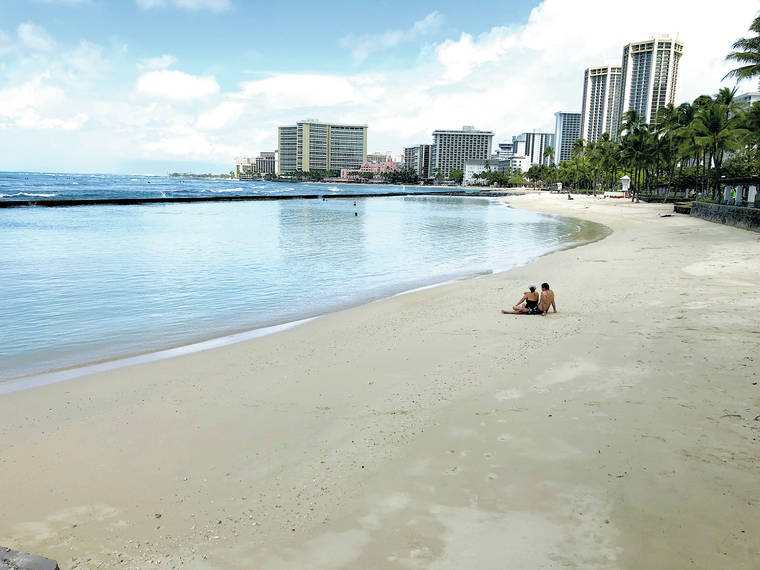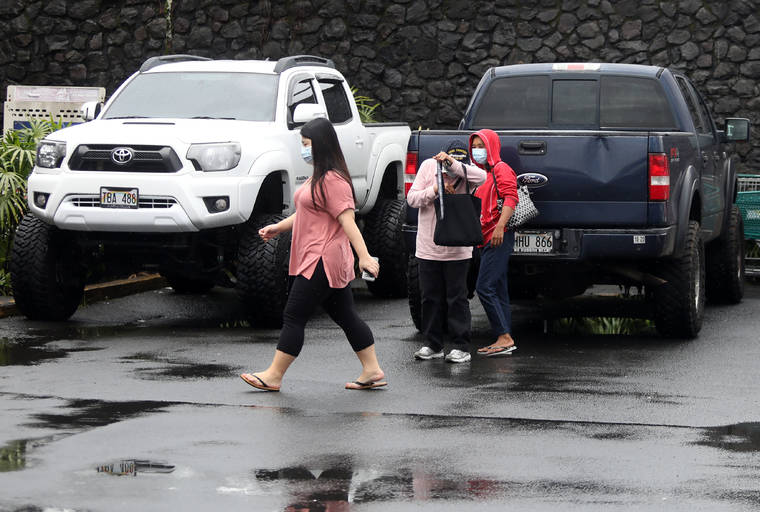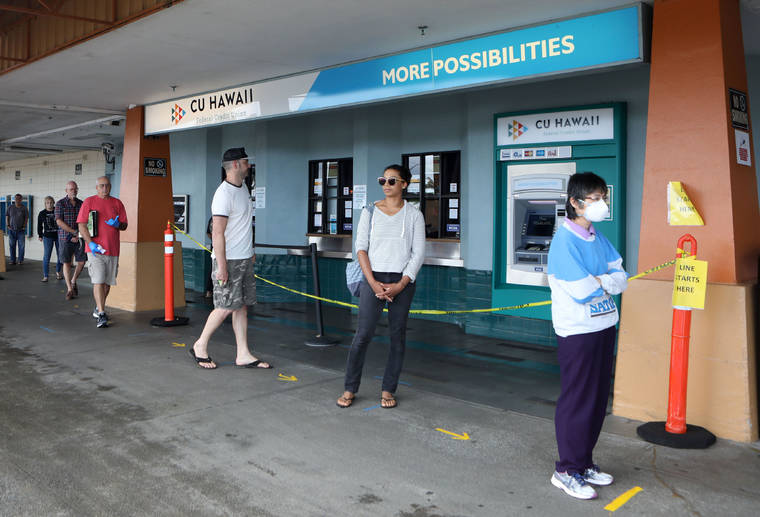Interisland travelers face quarantine; meanwhile, at least $4 billion in aid is slated for Hawaii

A couple sits on an empty section of Waikiki Beach in Honolulu on Saturday, March 28, 2020. Like many cities across the world, Honolulu came to an eerie standstill this weekend as the coronavirus pandemic spread throughout the islands. But Hawaii officials went beyond the standard stay-at-home orders and effectively flipped the switch on the state’s tourism-fueled economic engine in a bid to slow the spread of the virus. As of Thursday, anyone arriving in Hawaii must undergo a mandatory 14-day self-quarantine. The unprecedented move dramatically reduced the number of people on beaches, in city parks and on country roads where many people rely on tourism to pay for the high cost of living in Hawaii. (AP Photo/Caleb Jones)

KELSEY WALLING/Hawaii Tribune-Herald Shoppers adorning masks walk to the Sack N Save on Kinoole Street on Monday in Hilo. The parking lot was filled with people looking to buy provisions for the week ahead.

CHELSEA JENSEN/West Hawaii Today A woman sits on the rocks at Kamakahonu Bay fronting an empty King Kamehameha’s Kona Beach Hotel on Monday afternoon in Kailua-Kona. The coronavirus pandemic has plunged Hawaii’s economy into a recession that’s unprecedented for today, University of Hawaii Economics Carl Bonham told lawmakers on Monday.

KELSEY WALLING/Hawaii Tribune-Herald People wait in a line outside the KTA Super Stores location on Puianako Street on Monday in Hilo. The store provided a designated line with tape marking spots 6 feet apart. As patrons came out of the store with their groceries, more were let in to promote social distancing during essential business.
After midnight tonight, anyone taking an interisland flight who is not an essential worker traveling for legitimate work purposes will be subjected to “a mandatory 14-day self-quarantine,” Gov. David Ige said Monday.
After midnight tonight, anyone taking an interisland flight who is not an essential worker traveling for legitimate work purposes will be subjected to “a mandatory 14-day self-quarantine,” Gov. David Ige said Monday.
The new travel restriction, aimed at slowing community spread of the COVID-19 coronavirus, will be in effect through April 30, and those essential workers exempted from the self-quarantine will have to wear personal protective equipment during flights.
Ige didn’t immediately define what constitutes an “essential worker” for this travel restriction, but said a list would be issued later.
Visitors and returning residents entering Hawaii from elsewhere already are subjected to a mandatory 14-day self-quarantine, and the state is under a “shelter-in-place” order through April 30 that has the force of law.
Department of Transportation spokesman Tim Sakahara said March usually has a high rate of air travel because of spring break.
“Last year at this time, there were 33,000 people a day who were flying into the state of Hawaii,” Sakahara said. “This year, however, those numbers were down more than 96% compared to last year.”
Ige said that in response to the shortage of licensed medical practitioners in Hawaii, he signed an executive order Sunday that will allow out-of-state physicians and nurses to practice in Hawaii “provided they are currently authorized to do so in another state.”
The governor added that the directive will “provide for the increased use of telehealth services” and for child care services through the temporary waiver “of some administrative licensing rules.”
In addition, the executive order suspends certain state laws to allow counties and state agencies to engage in emergency management functions in regard to firearms registrations, wages and hours for government contractors, charter school rules, controlled substances registrations and dispensing, criminal history record checks, notary publics, sex offender registrations and certain employment and workers compensation laws.
As of noon Monday, the state Department of Health reported 204 cases of COVID-19 in Hawaii, an increase of 29 cases since Sunday’s total of 175.
Of the new cases, 24 are Hawaii residents, and five are of unknown residency, DOH said.
Sixteen of the new cases are in the City and County of Honolulu, three on Hawaii Island and five on Maui.
That brings the current number of confirmed Big Island cases reported to 15, DOH said.
Lt. Gov. Josh Green said six individuals statewide are in intensive care units because of COVID-19.
Green, a physician from Kona who spearheads the state’s COVID Task Force, said how quickly the state can “flatten the curve” of new cases depends on how compliant people are with the state’s stay-at-home order and directives on social distancing, which requires individuals stay at least 6 feet away from each other and bars gatherings of more than 10 people.
“If people don’t listen … there will be 8% more cases,” Green said. “Four days later, you will see a 15% gap, 15% more cases. And on the sixth day, if we continue to avoid good advice from the governor, we could see 43% more cases. And those 43% more cases represent hundreds of people who test positive for COVID-19, and they, themselves, will spread” the illness.
“That is how we lose. That’s how people die in the state of Hawaii. That’s why the governor was so smart to ensure that we stay at home.”
Green said there are 2,757 hospital beds available statewide, 338 intensive care unit beds and 534 ventilators available.
“If you see how fast this can go up, if we ignore the governor’s … advice to quarantine at home, home isolate, we outstrip our capacity to care for people,” he said.
Green did provide some promising statistics, however.
“We are using only 37% of our ICU beds,” he said. “That’s very good news, because that gives us some capacity to care for people if we get a surge. We’re using 58 of our 534 ventilators right now. … That’s just 11%. That means we are keeping it down.
“However, if we do not quarantine at home, those numbers go up very fast. And just four- or five-hundred people needing a ventilator will exceed our capacity to keep people alive.”
“With the recent travel quarantine requirements, we have a chance to lower the curve,” added state Health Director Bruce Anderson.
“We’ve essentially eliminated the cases we’ve seen associated with travel, and now it’s really a question of us focusing on social distancing,” Anderson said. “It’s OK to go out for a walk, take your dog for a walk, go jogging, go surfing. But do so individually, and honor those social distancing requirements.”
Two members of Hawaii’s congressional delegation also participated in the conference, highlighting federal funds related to the COVID-19 pandemic the state and its residents should receive soon.
U.S. Sen. Brian Schatz, speaking by telephone, said that Hawaii’s share of the $2.2 trillion federal stimulus package called Coronavirus Aid, Relief and Economic Security Act, or CARES, will be “a minimum of $4 billion.”
“These monies are for COVID response in terms of allowing people to survive economically, and also attacking and mitigating the virus itself,” Schatz said. He added that government’s obligation is to “work together, to work efficiently and to recognize that people across the state are going to need more financial assistance and a government and a society that moves at the speed of this virus.”
Schatz said the act will provide for a $1.25 billion transfer of money from the feds to the state and county governments, about $1.24 billion in direct payments to people in Hawaii and a “very low estimate” of $1.14 billion for the expansion of unemployment benefits.
Also provided, he said, will be $130 million for the Supplemental Nutrition Assistance Program, or SNAP, $53 million for the state Department of Education and “tens of millions of dollars for other social services.”
“What that $4 billion does not include is the small business program that is being ramped up as we speak,” Schatz said. “And the local banks are ready to roll, and the local (Small Business Administration) is ready to roll. But we did not put a number on that, because it really depends on our ability to execute loans and the participation rate.”
Schatz said the bill also is separate from “a $100 billion hospital fund, nationally,” which will provide extra resources to local hospitals and nursing homes.
U.S. Rep. Ed Case noted the bill is the “largest single emergency bill in the history of our country, as well it should be considering the magnitude of what we face.”
He said it contains about “$500 billion nationally (for) our industries, targeted to keep people on the job.”
“These are not simply handouts to companies or businesses, these are assistances designed to keep employees on the job, whether you’re able to work or not,” Case said. “We want payrolls to continue across our country.”
Email John Burnett at jburnett@hawaiitribune-herald.com.


